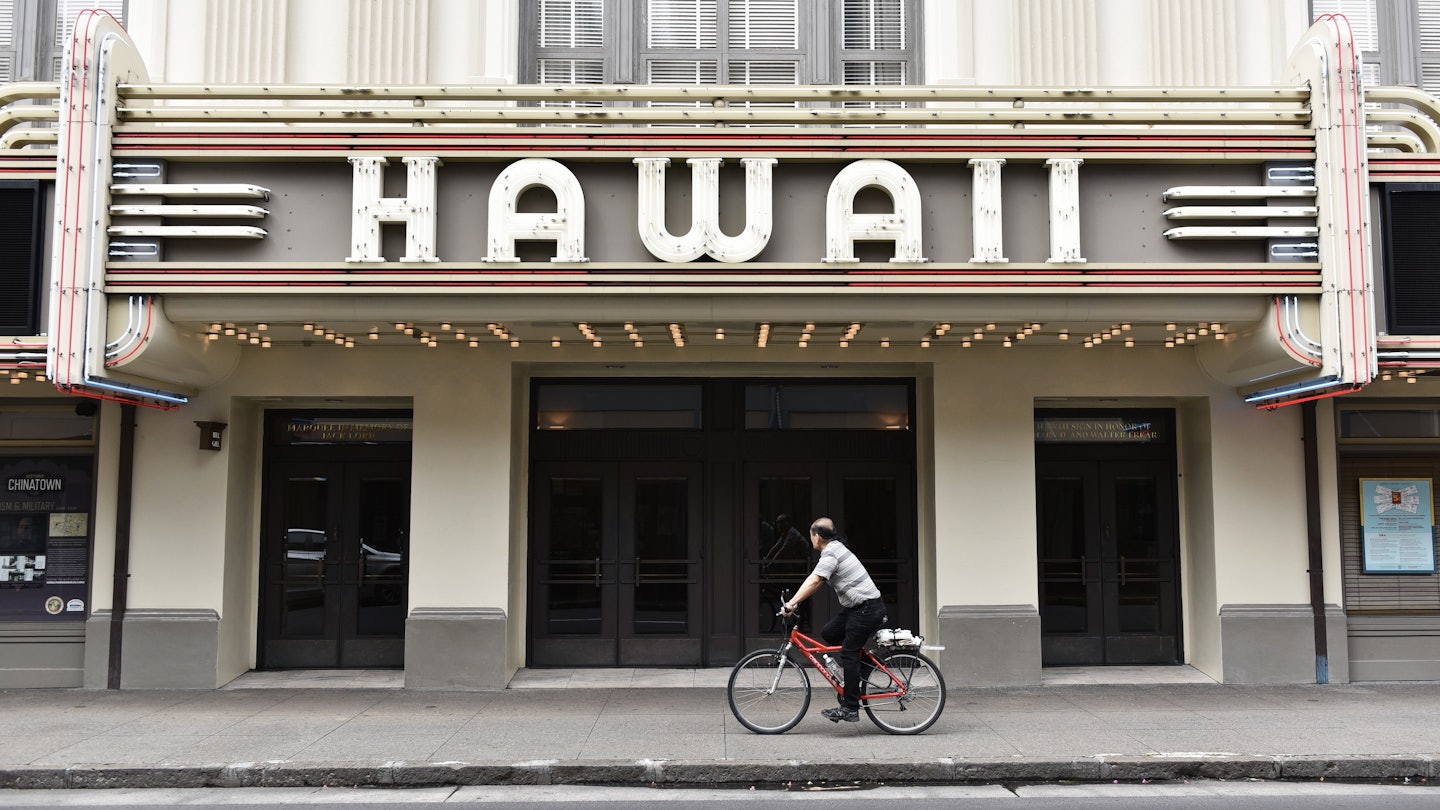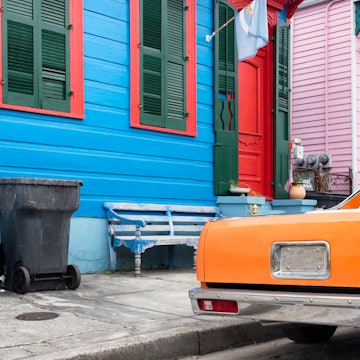
10 ideas for enjoying famously pricey Hawaii on a budget

Dec 3, 2024 • 9 min read

By following a few tips – like favoring cycles or mass transit over long car rentals – you can stretch your dollars in this famously expensive state. Shutterstock
There’s a saying in Hawaii: there’s a cost to paradise.
Among US states, Hawaii consistently ranks at the top for cost of living. The median price of a single-family home on O‘ahu, for example, is more than $1.1 million. And gas can cost as much as $5 a gallon.
Yet with a little homework, there are plenty of ways to enjoy the islands’ pristine beaches, local flavors and stunning natural beauty without spending a fortune. This guide to daily costs in Hawaii, along with top tips for budget travelers, can help you save your dollars. And even allow you to sample some of the best of the islands for free.
Daily costs
Hostel room: $40–150 a night
Basic room for two: $150–300 a night
Self-catering apartment (including Airbnb): from $80 (for a private room) up to $6000 a night (where President Obama stayed in Kailua)
Public-transport ticket (TheBus on Oʻahu): $3 (adult, one way), with discounts for seniors ages 65 and up and youth ages 6 to 17.
Coffee: $2.25 (hot coffee at Starbucks) to $12.50 (Kona Estate coffee brewed fresh, using the Chemex pour-over brewer at Honolulu Coffee)
Sandwich: from $7 (Andy’s Sandwiches & Smoothies) to $13 (at Sprout Sandwich Shop)
Dinner for two: $50–500
Beer/pint at the bar: $7–12

Plan a fall or spring vacation
Hawaii is a year-round destination – and that’s good news for travelers on a budget. You can find deals on airfare and accommodations during the slower shoulder months – September and October, January and February, April and May – and by avoiding peak travel times like summer, winter and spring break.
Be strategic about island-hopping...
Why fly all the way to Hawaii and stay in just one place? If you’re set on seeing more than one island on your vacation, you should take advantage of cheaper options on interisland airfares.
Southwest Airlines offers one-way rates that are sometimes as low as $39, with no-frills service and no assigned seating. Mokulele Airlines operates Cessna 208EX Grand Caravans that seat up to nine passengers and fly into smaller airports, offering round-trip fares for under $200 per person.
Planning tip: If you’re on Maui and want to visit Lanaʻi, you can book a ride on the Expeditions Maui-Lanaʻi Passenger Ferry. Tickets start at $40 one-way; the journey takes about an hour. Bonus: if you’re traveling between islands from January to April, you may see humpback whales along the way.

...or simply stick to one island
Those extra airfares and accommodations can add up quickly, making island-hopping pricey. What’s more, if you’re not on Oʻahu, you’ll likely have to rent a car, the price of which fluctuates with demand.
By staying on just one island, you can explore everything it has to offer. Oʻahu brims with countless restaurants, shopping, beaches, museums and hiking trails. Maui is just as vibrant, with more country charm and quaint towns like Hana and Makawao. (Note that the island is still rebuilding after the devastating 2023 Lahaina Wildfire, and that traveling responsibly in Maui is more important now than ever.)
Kauaʻi is the most laid-back of all the islands, with verdant landscapes, breathtaking beaches and a quieter pace. Hawaiʻi Island (aka the Big Island) boasts active volcanoes, rolling ranchland and old-Hawaii charm.
Keep your car-rental period short
While skipping a car rental altogether may be the most cost-effective option, it’s also very limiting – even on Oʻahu, which boasts a great public-bus system. Whichever island you’re on, you’ll want to get out of resort zones and venture into different neighborhoods, find hole-in-the-wall eateries and experience the islands the way locals do.
Instead of renting a car at the airport for the duration of your stay, consider an à la carte approach, renting a car for just a day or two – and optimally keeping your transit costs under $100.

Use local rideshare services and rental companies
All of the main islands have rideshare services like Uber and Lyft, with O‘ahu featuring the best coverage (and coverage being spotty on smaller islands such as Kauaʻi). But there are new local services, too.
In June 2021, new rideshare company Holoholo launched on Oʻahu, Maui, Kauaʻi, Hawaiʻi Island and Lanaʻi with a wider selection of choices – think hybrid cars, electric and luxury vehicles, drivers pre-approved to enter US military bases, and options for those requiring additional mobility assistance. Fares are based on distance and calculated up front, and rides can be scheduled in advance.
Car-share app Turo also recently entered the Hawaii market, offering the more affordable option of renting vehicles directly from local owners.
Hui Care Share is a round-trip, station-based car-share program (on Oʻahu only) that allows you to book a vehicle by the hour or day, now or in the future. The service includes 170 vehicles parked at 65 stations throughout urban Honolulu – downtown, Waikiki, Kakaʻako, Ala Moana, Mānoa, Kaimukī – and Ko Olina. The best part? Gas, insurance and roadside assistance are all included.
Take public transportation
You can also ditch the cars entirely – and eliminate stress about notoriously scant parking – by using public transportation.
On Oʻahu, there's TheBus, a public operator with a fleet of 542 buses providing daily services on 101 routes across the island. Adult fares are $3 (one way), to be paid in cash upon boarding, with discounts for seniors ages 65 and up and youth ages 6 to 17. TheBus conveniently stops at some of the island’s most popular visitor destinations, including Waikiki, Ala Moana Center, Bishop Museum, Kualoa Ranch, Polynesian Cultural Center, Pearl Harbor, Waimea Valley and Hanauma Bay.
Maui also operates a public bus system with service in various parts of the islands, from Kaʻanapali to Upcountry.
Pedal around by bike
Another option is to ride around Oʻahu on a bike using the island’s only bikeshare program, Biki, which has 1300 bikes at more than 130 self-service Biki Stops throughout Honolulu.
It’s a great option for short jaunts to the beach or to grab lunch nearby. Rides cost $5 per bike for a single ride for up to 30 minutes, $20 for unlimited rides within 24 hours or $55 for 300 minutes to use in any increment for one year (the best option to use over an entire vacation stay).

Count on free access to Hawaii’s beaches, hiking trails and gardens – with small fees for some of the best ones
You can count on enjoying the best parts of Hawaii – its beaches, gardens, parks and hiking trails – without spending much. And while most beaches in the state are free and accessible year-round, a few top ones – like Hanauma Bay on Oʻahu and Hāʻena State Park on Kauaʻi – require reservations with a small fee for visitors.
Pristine nature reserve Hanauma Bay has an online reservation system, limiting the number of visitors to fewer than 800 a day. It costs $25 per person to enter (free for Hawaii residents and children aged 12 and under) and another $3 for parking ($1 for residents). To visit Hāʻena State Park – which includes Kēʻē Beach and the start of the Kalalau Trail along the famed Nāpali Coast – you’ll need to secure a reservation and pay a $5 entry fee and $10 for parking (free for residents).
While state-run hiking trails are normally free to access, some have small fees. For non-residents, it costs $5 to hike to the top of Diamond Head (Lēʻahi in Hawaiian) on Oʻahu, plus $10 for parking (both payable by credit card only), or to visit the popular ʻIao Valley State Monument on Maui. Reserve your place in advance online.
Most botanical gardens charge a nominal entrance fee – though some, including the popular city-run Hoʻomaluhia Botanical Garden on Oʻahu, are free to explore.
Feed yourself affordably with bento boxes and poke bowls
While each island boasts upscale farm-to-table restaurants that will break your food budget, Hawaii is also known for its homestyle local cuisine. All over the islands, plate lunches, bento (Japanese box meals) and poke bowls (cubed ahi, raw and seasoned, and served atop rice) are plentiful – and affordable.
Get loaded plates of teriyaki beef, shoyu chicken or hamburger steak and gravy at popular drive-ins, such as Rainbow Drive-In on Oʻahu, Hawaiian Style Cafe on the Big Island and Tin Roof on Maui.
We also recommend seeking out okazu-ya (Japanese deli-type eateries), which serve à la carte portions of local favorites – shoyu pork, chow fun noodles, shrimp tempura and musubi (rice balls). Some popular ones include Kawamoto Store on the Big Island, Fukuya Deli on Oʻahu, Honokowai Okazuya & Deli on Maui and Po’s Kitchen on Kauaʻi. And poke bowls are everywhere – affordable, filling, balanced and simply delicious meals you can grab even from convenience stores.
Planning tip: If you have a short-term rental with a kitchen, you may want to save money by cooking in. Hit up one of the many farmers markets run by the Hawaiʻi Farm Bureau Federation or FarmLovers Markets. You can meet local producers, buy fresh and local goodies and even pick up artisan-made products such as jams, hot sauces, cookies, vinegars and honey. Many serve prepared foods too.

Find free and low-cost activities and tours
You don’t need to cap off your Hawaii experience with a pricey luau or helicopter tour. Indeed, perhaps the best way to connect with the rich culture here is through a free (or inexpensive) class around town.
Many hotels and malls offer free entertainment and classes in cultural practices, such as lei-making, ukulele-playing and hula. The Royal Hawaiian Center in Waikiki offers all that, plus lauhala-weaving and free Hawaiian entertainment. Kāʻanapali Beach Hotel by Outrigger on Maui provides complimentary cultural classes to its guests at its hale hoʻokipa (hospitality house): you can learn to hula, make tapa cloth, restring kukui-nut leis, speak short words and phrases in ʻōlelo Hawaiʻi (Hawaiian language), and even find your way around with pānānā, or traditional navigational techniques.
On Oʻahu, you can rent surfboards at stands along Waikiki Beach for about $20, or pay a little more for a lesson from a beach attendant. You can also rent surfboards, stand-up paddle boards, kayaks, boogie boards with fins, snorkel gear and more from Surf in the City Waikiki.
Opt for self-guided tours to save some money. Holualoa Kona Coffee Company on the Big Island offers free coffee-roasting tours and samplings for a small fee. Stroll the grounds of the state’s largest coffee grower, Kauai Coffee Co, at your leisure to learn about coffee and its history in the islands.
For about $35, you can go on a walking tour of Oʻahu’s historic Chinatown district with the Hawaiʻi Heritage Center, where you learn about the rich history of Chinese immigration to Hawaii through the neighborhood and its architecture. The price includes gallery entry, visits to sites with cultural and historical significance, and samples of food from neighborhood shops and restaurants.
Planning tip: Download the Shaka Guide app for self-guided GPS audio tours of popular attractions across the islands. Featured tours include Road to Hana on Maui, Hawaiʻi Volcanoes National Park on the Big Island and Waimea Canyon on Kauaʻi. Each tour costs $20 and doesn’t require a data connection to enjoy.















